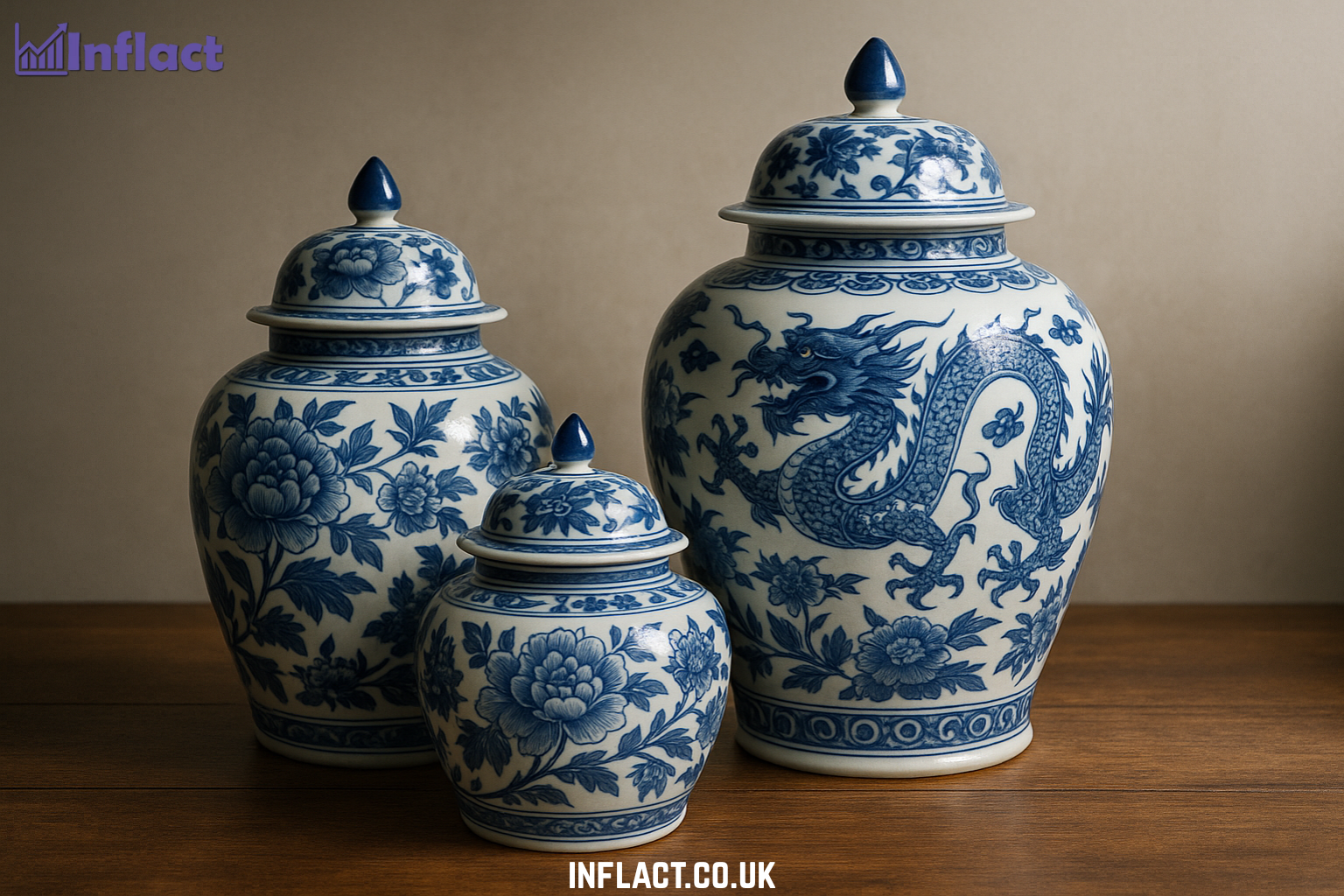Introduction
Ginger jars are one of the most timeless and recognizable ceramic designs in the world of interior décor. Originating from ancient China, these lidded jars have traveled across continents and centuries—once serving practical purposes, and now celebrated as decorative art pieces in homes, museums, and modern spaces.
Whether you’re a lover of vintage aesthetics, interested in oriental art, or simply looking to enhance your home with unique accent pieces, ginger jars offer a blend of historical significance, cultural charm, and contemporary style.
The Origins and History of Ginger Jars
Ginger jars first appeared in China during the Tang Dynasty (618–907 AD). Originally, they were utilitarian vessels used to store spices like ginger (hence the name), salt, oils, and even medicinal herbs. Made of porcelain and later decorated with intricate hand-painted patterns, these jars quickly gained aesthetic value.
During the Ming Dynasty (1368–1644), ginger jars became more ornate and were widely exported to Europe. There, they were collected by nobility and appreciated for their exotic look and craftsmanship. Over time, ginger jars evolved from storage containers into decorative collectibles, influencing Western interior design trends and remaining relevant to this day.
Also Read: 18000 BTU Mini Split: The Smart Choice for Efficient Home Climate Control
Key Features and Common Designs
Ginger jars are easily identified by their rounded body, narrow neck, and dome-shaped lid. While traditional jars were made of white porcelain with blue floral or landscape motifs, today’s designs range from minimalistic solids to vibrant, multi-colored variations.
Popular Styles:
- Blue and white porcelain – the most classic look, often featuring dragons, birds, or floral motifs.
- Chinoiserie patterns – inspired by Western interpretations of Chinese designs.
- Monochrome jars – solid-colored versions that suit modern, minimalist spaces.
- Metallic or gilded jars – often used in glam or luxury interiors.
These jars are available in various sizes, from small tabletop versions to large floor-standing pieces, making them highly versatile in home décor.
Uses of Ginger Jars in Modern Décor
Although ginger jars are no longer used for storing spices, they have become a staple in interior styling and home decoration.
Common decorative uses:
- Vases – with or without the lid, ginger jars can hold fresh flowers or artificial stems.
- Table centerpieces – a pair of jars can add balance and elegance to dining tables or consoles.
- Shelf or mantel accents – smaller jars enhance visual interest on open shelving or fireplace mantels.
- Entryway statements – large jars can be used on the floor to create a welcoming display.
- Color coordination – select jars that match or contrast your home’s color palette for a curated look.
By mixing styles, sizes, and finishes, you can create a display that reflects your personal taste—whether it’s traditional, coastal, farmhouse, or contemporary.
Collecting Ginger Jars: Tips for Enthusiasts
For many people, ginger jars are not just décor—they’re collectibles. From vintage pieces to limited-edition designs, collectors appreciate both the history and the artistry.
Things to consider when collecting:
- Age: Antique jars are more valuable and often feature hand-painted details with slight imperfections.
- Markings: Look for symbols or signatures on the base, which can indicate origin and era.
- Material quality: Genuine porcelain has a fine, smooth texture and a slight translucency.
- Condition: Cracks, chips, or faded paint can lower value, especially for antique jars.
Modern jars may not have historic value but can still be treasured for their beauty and craft. Mixing old and new creates dynamic displays with depth and contrast.
Step-by-Step Guide: Styling Ginger Jars in Your Home
Decorating with ginger jars can be simple yet impactful. Here’s how to do it:
Step 1: Choose a Space
Decide where you want to place your ginger jar—entry table, shelf, dining table, etc.
Step 2: Pick the Right Size
- Small jars: Ideal for bookshelves, mantels, or coffee tables.
- Medium jars: Versatile for dining tables, sideboards, or kitchen counters.
- Large jars: Best suited for floor displays or grand entrances.
Step 3: Select a Style
Choose colors and patterns that complement your existing interior style. Blue and white jars are safe, versatile options.
Step 4: Decide Lid On or Off
- Lid on: Traditional, classic display.
- Lid off: Doubles as a vase or catchall.
Step 5: Group for Impact
Use symmetry for formal looks (pairs on either side of a fireplace), or group different sizes together for a layered, casual arrangement.
Pro Tip: Place jars in odd-numbered groups (3 or 5) for a more balanced, designer look.
Also Read: Choice Home Warranty Awards: A Comprehensive Guide to Industry Recognition and Consumer Trust
Conclusion
Ginger jars are a perfect blend of tradition, function, and decorative flair. With origins rooted in ancient Chinese culture and a prominent place in modern home design, they’re both timeless and trendy. Whether you’re adding one to your living room or curating a whole collection, ginger jars bring a touch of global elegance to any setting.
If you appreciate fine ceramics, heritage pieces, or just want a stylish focal point for your room, a ginger jar is a worthy addition to your décor journey.
Frequently Asked Questions (FAQs)
1. Why are ginger jars called “ginger” jars?
They were originally used to store and transport ginger and other spices in ancient China, giving them their name.
2. Are ginger jars always blue and white?
No. While blue and white is the most classic design, modern ginger jars come in many colors, including gold, black, red, green, and more.
3. Can I use a ginger jar as a vase?
Yes! Simply remove the lid and add fresh flowers or decorative branches. They make stunning vases.
4. How do I clean a ginger jar?
Use a soft, damp cloth to wipe the surface. Avoid harsh cleaners, especially on hand-painted jars, as they can damage the glaze or paint.
5. Are ginger jars valuable?
They can be. Antique and hand-painted ginger jars are often collectible and may have significant value, depending on their age, origin, and condition.




